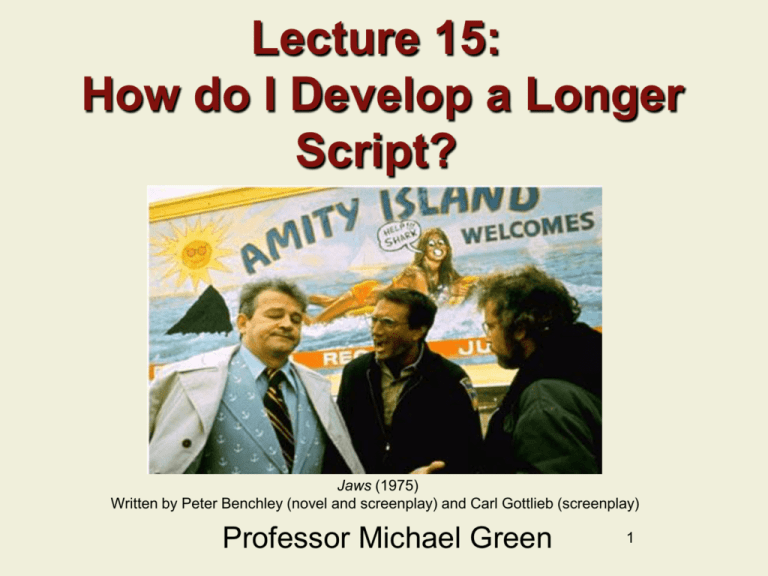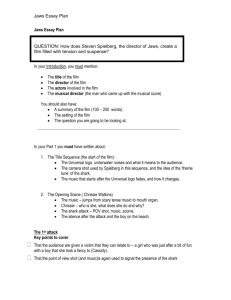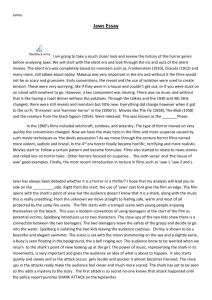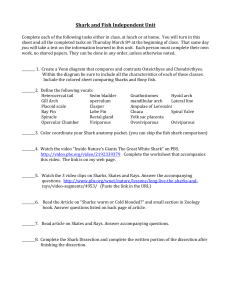Jaws
advertisement

Lecture 15: How do I Develop a Longer Script? Jaws (1975) Written by Peter Benchley (novel and screenplay) and Carl Gottlieb (screenplay) Professor Michael Green 1 Previous Lesson • Keeping on Track • Approaching Revision • Writing Exercise #13 Jaws (1975) This Lesson • Approaching the Feature Length Script • Jaws: Act I • Jaws: Act II • Jaws: Act III • E-board Jaws (1975) Approaching the Feature Length Script Jaws (1975) Lesson 15: Part I 4 Feature vs. Short • As we have seen, the feature differs from the short in several important ways including: – Thematic material – Audience sympathy with the protagonist – Number of subplots – Nature of the antagonist – Length and complexity of the set-up • However, as we have also seen, most of the same elements of storytelling exist in both. 5 Act I: The Set Up • Inciting Incident • Problem and sub-problem (related to conflict and theme) • Main Exposition • Visual interest • Raise questions/be compelling • Open up a world at least slightly different than ours Jaws (1975) Act II: Development • Momentum and Focus • Accelerating Conflict (Cause and Effect) • The Midpoint • Reversals • Obstacles/Complications • Jeopardy/the Dreadful Alternative Jaws (1975) Act II: Development (Continued) • Suspense • Surprise • A Flawed Protagonist • A Strong Antagonist • The Pseudosolution Jaws (1975) Act III: The Pay Off • • • • • Revelation Crisis Climax Change and Choice Resolution Jaws (1975) Jaws • Jaws is a famous production that highlights both the problems that arise during the creative process of filmmaking as well as the innovation necessary to overcome them. • Jaws was a watershed moment in the history of film. Along with Star Wars, it is credited with ushering in the era of the blockbuster (which we are still in). It changed the way that films are distributed and exhibited. 10 The Production of Jaws • Based on a bestseller by Peter Benchley • Rights acquired by producers Richard Zanuck and David Brown • Spielberg tapped as director – His second feature film after The Sugarland Express and the TV film Duel 11 Problems • The film was pushed into production early • It was a technical nightmare – The shark almost never worked • Slow production with a lot of pressure from the studios to finish it. 12 Jaws: Act I Jaws (1975) Lesson 15: Part II 13 The Inciting Incident • The inciting incident in Jaws is near the movie’s opening when the young girl goes out swimming and is attacked. • After this point, balance cannot be restored to the community until the problem set in play by the inciting incident is solved. • Pause the lecture and watch Clip #1. 14 The Inciting Incident (Formatted) EXT CHRISSIE IN THE WATER Her expression freezes. The water-bulge is racing towards her. The first bump jolts her upright, out of the water to her hips. She reaches under water to touch her leg. Whatever she feels makes her open her mouth to scream, but she is slammed again, hard, whipped into an arc of about eight feet, up and down, submerging her down to her open mouth, choking off any scream she might try to make. Another jolt to her body, driving her under so that only her hair swirls on the surface. Then it too is sucked below in a final and terrible jerking motion. HOLD on the eddies and swirls until we're sure it's all over. 15 The Problem and Sub-problem • The problem in Jaws is that a great white shark has staked a feeding claim off the coast of a summer resort island and is eating swimmers. • The sub-problem is that the town selectmen and the mayor insist that the beaches stay open even though people are being killed. 16 Problems, Conflict and Theme • The problems are clearly related to the conflict. The protagonists (Chief Brody and Matt Hooper) must try to eliminate the danger of the shark. In pursuing this goal, they come into conflict with the mayor and the town selectman and with the shark itself. • The problems are also related to theme: – Man vs. nature – Wealth vs. the middle and working class 17 The Main Exposition • There is a great deal of exposition in the first act. Among other things we learn: – About Chief Brody and his family; significantly, we learn early on that they are outsiders. – About the character of Amity, the values of its people, and how it sustains its economy. – About sharks and what they are capable of. – About Quint and what he is willing to do. – About Hooper and how he can help. 18 Visual Interest • Even though Jaws has a lot of dialogue, the screenplay allows for much of the story to be told in actions and images. • There are frightening scenes on the ocean and the beach that work mostly because of the way action, characters, images and location interact with little dialogue. – The opening scene – The scene with the two fisherman and the roast Raising Questions • The movie raises a number of questions in the first act to keep the audience interested: – What is the nature of the shark and how dangerous is it? – How much more damage/terror will it perpetrate? – Will it be caught and how? – Will Chief Brody triumph over the corrupt mayor? – Will Chief Brody conquer his fears/inadequacies and be able to act to solve the problem? Opening Up a Different World • Though Amity bears resemblance to beach towns of the time (the movie was filmed in Martha’s Vineyard), it is not a real place. • It is strangely self-contained; despite the problems it is having, it has very little contact with the outside world. • The shark problem is one that few of us would ever have to deal with. • Specific, unique characters. 21 Jaws: Act II Jaws (1975) Lesson 15: Part III 22 Momentum and Focus • Maintaining the momentum in a featurelength screenplay is clearly more difficult than maintaining it in a short. • The key is developing lots of conflict, and inventing enough complications, obstacles, triumphs and setbacks for your protagonist – usually about 60 pages worth in Act II. • Maintaining the momentum depends on the strength of the set-up, problem and goals. 23 Accelerating Conflict • Remember, the acceleration of conflict works on a cause and effect basis: your protagonist takes action, meets reaction, and vice-versa throughout the script. • In Jaws, Brody is fighting on two fronts, against the shark and against the mayor. • Up until the midpoint, there are a series of actions and reactions as Brody fights both antagonists with mixed success. 24 The Midpoint • Finally, at the midpoint, Brody triumphs over the Mayor, convincing him to hire Quint to kill the shark (this comes almost exactly at the actual midpoint of the film, about 62 minutes in). • The second half of Act II now focuses on the battle against the shark – though the rest of the act is also developing another adversary for Brody and Hooper in Quint, who they will face in Act III. 25 Reversals • The midpoint, when Brody triumphs over the Mayor, is one reversal. • Other reversals come at the end of acts. • At the end of Act I, a shark is caught that turns out not to be the real shark and Brody’s resolve is strengthened when he is blamed for the child’s death. • At the end of Act II, the shark attacks them. • At the end of Act III, Brody kills the shark. 26 Obstacles and Complications • Chief Brody, Hooper, and later Quint face a number of obstacles and complications as they pursue their goals, including: – The beaches being re-opened – Lack of cooperation and obfuscation by the mayor, selectman, coroner, citizens of Amity – Ignorance/lack of knowledge – A shark that’s bigger than previously thought – Quint’s madness – Tools and weapons that don’t work 27 Jeopardy and the Dreadful Alternative • The protagonists (and their families) are put into jeopardy a number of times as they work to achieve their goal – usually as a result of getting into a position where they might be killed by the shark, though Chief Brody’s job is also in jeopardy. • The dreadful alternative to not killing the shark is that the protagonists and people close to them may be killed if they don’t. 28 Suspense • Jaws is very suspenseful because for most of the film the audience never knows when the shark will attack or how dangerous it is. • Spielberg conceals the shark for as long as possible to maintain suspense. Instead of showing it we hear about it, see the results of its attacks, look at pictures from books and hear stories about sharks. • He also uses humor to break and catch us off guard. • Pause the lecture and watch Clip #2. 29 Surprise • A number of surprises in Jaws keep the audience interested and guessing. – A girl gets killed on a nighttime swim. – The mayor insists on keeping the beaches open. – The woman whose son dies blames Brody. – The panic on the 4th of July results from a prank. – The shark then shows up in the estuary where Brody’s son is. – Quint reveals that he was on the Indianapolis. – Quint busts up the radio/ruins the engine. 30 A Flawed Protagonist • Chief Brody is a classic flawed protagonist. The screenplay gives him a number of weaknesses and shortcomings including: – His fear of water – His naiveté about the ways of the town – His ignorance about everything nautical – His ignorance about sharks – His mistakes in giving into the town selectman 31 A Strong Antagonist • Brody does not face a strong antagonist in a classical sense, a human foe that matches him step for step, is equally powerful, and has clearly conflicting goals. • However, he does face three antagonists at different points in the film: the shark, the Mayor and Quint. 32 The Pseudo-Solution • The pseudo-solution in Jaws comes near the midpoint, when Brody is given the resources to make the beach safe. • However, when this fails (the shark throws everybody off by feeding in the estuary) the protagonist must make the choice that leads to the real solution, in this case, hiring Quint to kill the shark. • On the boat, a number of pseudo-solutions are tried before the solution at the climax. 33 Jaws: Act III Jaws (1975) Lesson 15: Part IV 34 Revelation • Jaws is a relatively simple story in terms of character psychology and the revelations generally don’t turn on insight. • However, there are a number of minor revelations in Jaws and one major one. • Minor revelations include the knowledge that the girl was attacked by a shark, that the caught shark is not the real shark; that the real shark is bigger than realized; etc. Revelation (Continued) • The major revelation comes when Quint reveals that he was on the Indianapolis. – Exposition • This explains his behavior and leads to another revelation – that the three men are in trouble and on their own. – Consequences Crisis • There are a number of crises in Jaws, which force the characters to take action. • The main crisis occurs when the conflict intensifies and increases, causing the action to rise for the last time. The main crisis leads to the film’s climax. • The main crisis happens early in Act III, when the men are stranded on a sinking boat and the shark is now actively attacking them. • Pause the lecture and watch Clip #3. Climax • The climax is the highest, most exciting point in the drama, where the conflict must finally be resolved, putting the world of the movie back into balance. • In Jaws, the climax comes when Quint is eaten, the ship is almost completely sunk and Brody blows up the shark. • Notice how the solution to the problem is foreshadowed earlier in the film. • Pause the lecture and watch Clip #4 Change and Choice • Again, Jaws is not psychologically complex and the protagonist does not make a major choice that defines and changes him. • However, Brody does make a series of smaller choices along the way that show him to be a brave, determined man who is willing to confront his fears for the common good. 39 Resolution • Jaws has a very short resolution – the shark is killed and Brody and Hooper will evidently survive to bring the happy news to Amity (unless they are eaten by another shark on the way to shore). • The resolution is only a minute or so long – the screenwriter realizes that tying up loose ends involving the characters and the town will be ultimately anti-climatic. 40 E-Board Jaws (1975) Lesson 13: Part IV 41 E-Board Post #1 • How are the themes of Jaws that I discussed earlier – man vs. nature and wealth vs. the middle and working class – manifested in the film? Are there other themes present that I didn’t mention? 42 E-Board Post #2 • Discuss one or two of your ideas for a full length screenplay and your plan for keeping focus and momentum as you write it. 43 End of Lecture 15 Congratulations, you’ve finished the course!







